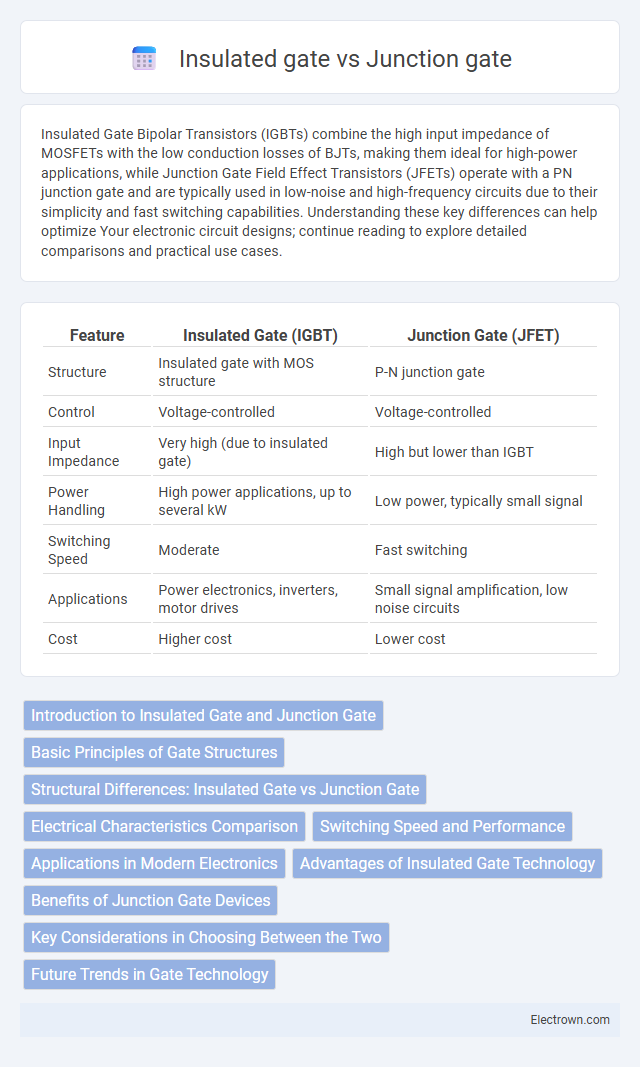Insulated Gate Bipolar Transistors (IGBTs) combine the high input impedance of MOSFETs with the low conduction losses of BJTs, making them ideal for high-power applications, while Junction Gate Field Effect Transistors (JFETs) operate with a PN junction gate and are typically used in low-noise and high-frequency circuits due to their simplicity and fast switching capabilities. Understanding these key differences can help optimize Your electronic circuit designs; continue reading to explore detailed comparisons and practical use cases.
Table of Comparison
| Feature | Insulated Gate (IGBT) | Junction Gate (JFET) |
|---|---|---|
| Structure | Insulated gate with MOS structure | P-N junction gate |
| Control | Voltage-controlled | Voltage-controlled |
| Input Impedance | Very high (due to insulated gate) | High but lower than IGBT |
| Power Handling | High power applications, up to several kW | Low power, typically small signal |
| Switching Speed | Moderate | Fast switching |
| Applications | Power electronics, inverters, motor drives | Small signal amplification, low noise circuits |
| Cost | Higher cost | Lower cost |
Introduction to Insulated Gate and Junction Gate
Insulated gate and junction gate are critical components in semiconductor devices with distinct structures and functions. Insulated gate transistors, such as MOSFETs, use a thin oxide layer to separate the gate terminal from the channel, enabling high input impedance and efficient switching. Junction gate devices, like JFETs, rely on a pn-junction to control current flow, offering robustness and low noise in analog applications.
Basic Principles of Gate Structures
Insulated gate structures, such as those found in MOSFETs, use a thin oxide layer to electrically isolate the gate from the semiconductor, allowing precise control of channel conductivity through voltage application. Junction gate structures, common in JFETs, rely on a p-n junction to modulate the channel by reverse-biasing the junction, controlling current flow without an insulating layer. Understanding these fundamental differences in gate insulation and control mechanisms can help you choose the right device for low-power or high-frequency applications.
Structural Differences: Insulated Gate vs Junction Gate
Insulated Gate Field-Effect Transistors (IGFETs) feature a gate electrode isolated from the channel by a thin oxide layer, enabling voltage control without direct current flow through the gate. In contrast, Junction Gate Field-Effect Transistors (JFETs) use a PN junction formed between the gate and channel, where the gate voltage modulates the depletion region to control current conduction. The oxide insulation in IGFETs provides higher input impedance and reduced gate leakage compared to the direct semiconductor junction in JFETs.
Electrical Characteristics Comparison
Insulated Gate Bipolar Transistors (IGBTs) feature high input impedance and low on-state voltage drop, enabling efficient high-voltage and high-current switching with reduced power loss. Junction Gate Field-Effect Transistors (JFETs) operate with a depletion-mode channel, exhibiting low noise and fast switching suitable for low-power analog applications but with higher on-resistance compared to IGBTs. IGBTs integrate MOSFET input characteristics with bipolar conduction, providing better performance in high-voltage power electronics, while JFETs are optimized for low-voltage, high-frequency signal amplification due to their voltage-controlled resistance.
Switching Speed and Performance
Insulated Gate Bipolar Transistors (IGBTs) offer slower switching speeds compared to Junction Gate Field-Effect Transistors (JFETs) due to their bipolar structure, but they excel in high-voltage and high-current applications. JFETs provide faster switching speeds and lower on-resistance, enhancing performance in low-power, high-frequency circuits. The intrinsic gate insulation in IGBTs results in higher input impedance, while JFETs rely on a reverse-biased P-N junction, influencing their switching dynamic and overall efficiency.
Applications in Modern Electronics
Insulated Gate Bipolar Transistors (IGBTs) dominate in high-power applications such as electric vehicles, renewable energy inverters, and industrial motor drives due to their high efficiency and voltage handling capabilities. Junction Gate Field-Effect Transistors (JFETs) excel in low-noise analog circuits, RF amplifiers, and precision sensor interfaces because of their low input capacitance and fast switching speeds. The choice between insulated and junction gate devices hinges on the specific requirements for power, speed, and noise performance in modern electronic systems.
Advantages of Insulated Gate Technology
Insulated Gate Technology offers superior control over semiconductor channels, enabling higher input impedance and lower power consumption compared to Junction Gate devices. The insulation layer in Insulated Gate devices prevents direct current flow between the gate and channel, significantly reducing leakage currents and enhancing device reliability. This technology supports faster switching speeds and improved thermal stability, making it ideal for high-frequency and power-efficient applications.
Benefits of Junction Gate Devices
Junction gate devices offer advantages such as simpler construction, lower manufacturing costs, and faster switching speeds due to their majority carrier conduction. They exhibit lower on-resistance, which results in better efficiency for certain power electronic applications. Their robustness against high voltage stress makes them suitable for high-power and high-frequency circuits.
Key Considerations in Choosing Between the Two
When choosing between Insulated Gate and Junction Gate devices, consider the gate control structure's impact on switching speed and power efficiency. Insulated Gate devices offer high input impedance and fast switching, making them ideal for low-power, high-frequency applications, while Junction Gate variants provide robustness and simpler fabrication suited for high-voltage environments. Your selection should align with the specific electrical characteristics and operational requirements of your circuit for optimal performance and longevity.
Future Trends in Gate Technology
Insulated Gate technology, including MOSFETs and IGFETs, is rapidly advancing with innovations such as high-k dielectrics and FinFET structures that enhance performance and reduce power consumption. Junction Gate devices, while historically significant, are increasingly being overshadowed by Insulated Gate transistors due to their superior scalability and efficiency in modern semiconductor manufacturing. Your future electronic designs will likely benefit from the ongoing evolution of Insulated Gate technology, offering improved speed, miniaturization, and energy efficiency.
Insulated gate vs Junction gate Infographic

 electrown.com
electrown.com